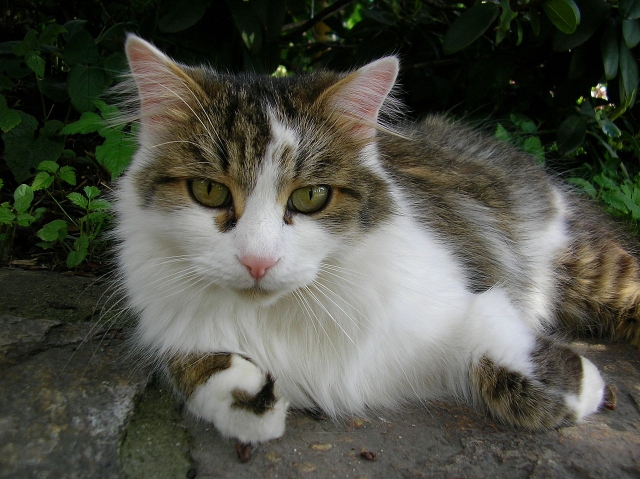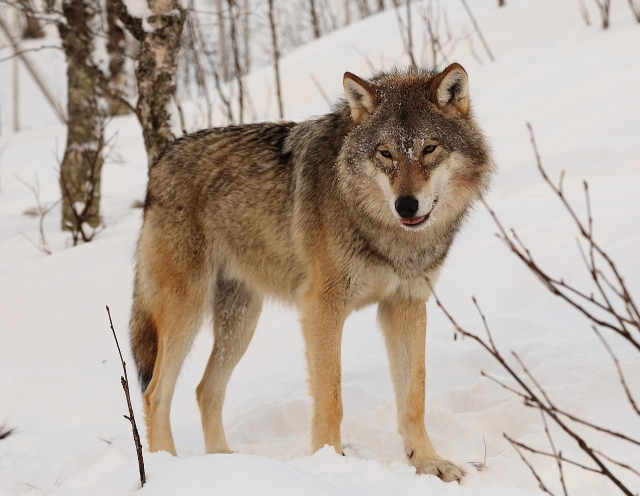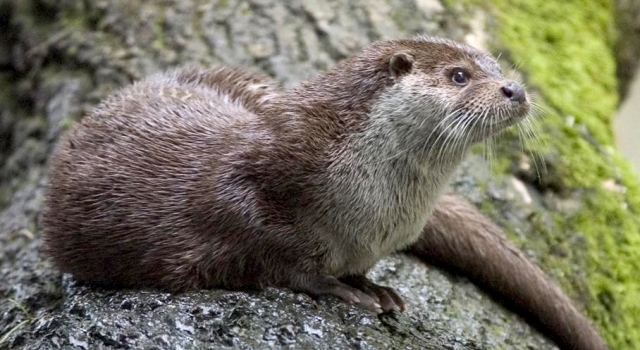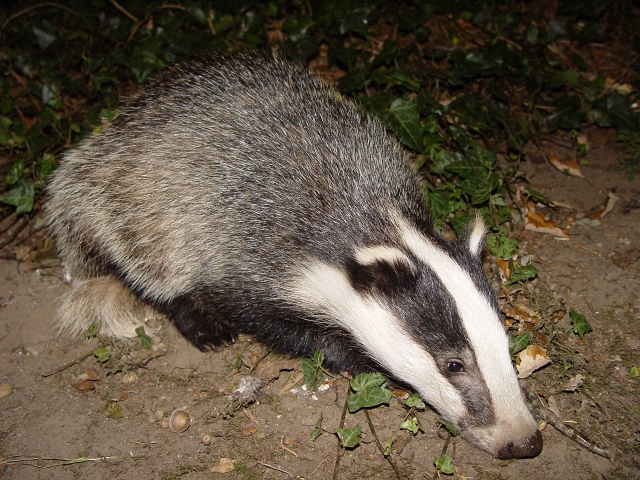Florian Heigl
Eurasian lynx
Description
With a snout-vent length of between 80 and 120 cm and a shoulder height of 50 to 70 cm, the Eurasian lynx is the largest cat in Europe after the Persian leopard, which is found in the Caucasus. The length of the back without the head and neck corresponds to the shoulder height, so that the physique appears square. The front legs are 20 percent shorter than the hind legs. The large paws prevent the Eurasian lynx from sinking deep into the snow.
What the Eurasian lynx has in common with the other species of the genus are the brush ears, the broad and roundish head and the very short tail. The tail of the Eurasian lynx is between 15 and 25 cm long and ends in a black tip. The Eurasian lynx is characterised by a very distinctive whisker, which it can spread wide.
The fur tips on the pointed, clearly triangular ears are up to five cm long.
The Eurasian lynx's coat is reddish to yellowish brown on the upperparts during the summer and grey to greyish brown during the winter months. The chin, throat, chest, belly and the inside of the legs are whitish grey to creamy white. The spotting of the coat varies from individual to individual, but it can also be almost completely absent.
Habitat
The Eurasian lynx prefers large forest areas with dense undergrowth as its habitat and uses open landscapes and human settlements only marginally and temporarily. Ideal conditions for hunting are provided by forests with a strong small-scale structure of old-growth islands, clearings, rocky slopes and marshland zones. However, Eurasian lynx can also be found in the rocky mountain zone up to an altitude of 2500 m. These habitats offer a large number of cover opportunities between rocks and bushes. Telemetric studies accompanying a number of reintroduction projects in recent decades have shown that Eurasian lynx hunt a large part of their prey in the fringes of forests, rarely entering agricultural land. During the day, Eurasian lynx stay in their hiding places and tolerate the proximity to humans. In the Vosges Mountains as well as in the Bavarian Forest, female Eurasian lynx raise cubs not far from places that are heavily frequented by tourists.
The text is a translation of an excerpt from Wikipedia (https://de.wikipedia.org/wiki/Eurasischer_Luchs). On wikipedia the text is available under a „Creative Commons Attribution/Share Alike“ licence. Status: 25 August 2021
Wildcat
Description
In appearance, the wildcat is more massive and muscular than the domestic cat and it has longer legs in relation to its body. Adult male wildcats have a snout-vent length of 55 to 65 cm, a tail of 27 to 32 cm and a weight of 3.8 to 7.3 kg. Females are much smaller with a snout-vent length of 47 to 57.5 cm and a tail length of 25 to 32 cm and a weight of 2.4 to 4.7 kg.
The basic colouring of the coat varies from yellowish-brown to reddish-grey to silver-grey. On the back there is often a typical, continuous black dorsal stripe ending at the root of the tail. The back and sides of the body are more or less heavily patterned with washed-out stripes. The stripe pattern is usually more pronounced in the west of the range than in the east. The tail is thick and relatively short, has a typical ringing with three to five dark rings and ends bluntly, always with a black tip. The skull is similar to that of the domestic cat, but with room for a larger brain. The eyes are wide apart. There is a small black spot on the sole. Another distinguishing feature is the light-coloured nose leather (pink).
Habitat
European wildcats live mainly in forests. Large populations occur in deciduous or mixed forests that are not disturbed by humans. They also live along coasts, at the edge of marshes, in riparian forests and in the Mediterranean maquis. They avoid areas with intensive agricultural use, pure coniferous forests, very high mountains, coastal regions without cover or areas that are more than 50 % snow-covered in winter, where the average snow depth is more than 20 cm or where the snow cover remains for a period of 100 days or longer.
In Austria, wildcats were formerly widespread in the Alpine foothills of northern, eastern and southern Austria. In the second half of the 19th century, populations were severely decimated and since then only a few specimens have been recorded. They were considered extinct, extirpated or lost in Austria, and only a few years ago there was no evidence of a resident reproducing population in Austria. However, in recent years there have been increasing reports of sightings south of the Danube and evidence of an occurrence in the Thayatal National Park was found.
The text is a translation of an excerpt from Wikipedia (https://de.wikipedia.org/wiki/Europäische_Wildkatze). On wikipedia the text is available under a „Creative Commons Attribution/Share Alike“ licence. Status: 25 August 2021
Domestic cat
Description
The characteristics of the domestic cat vary according to the area of distribution. In the bred forms they depend on the breed standards, in the synanthropic domestic cats they are subject to the respective selection pressure, which depends on the natural environmental conditions.
Domestic cats average about 50 cm in length (snout-vent length) and 4 kg in weight with a wide range of variation from about 2.5 kg to about 8 kg. Males are slightly larger than females. The length of the tail is about 25 to 30 cm. The shoulder height is 30 to 35 cm. In areas of distribution with colder climates, the cats are generally heavier and larger, in warmer areas they are lighter.
The domestic cat in the wild type has an m-shaped pattern on the forehead, " kajal " lines going from the eyes to the side, a dark dorsal stripe and dark horizontal stripes (or also spots) on the sides of the body. Legs and tail are also dark banded. Their colour varies from grey-black to warm brown tones. Besides the wild type described above, other markings and a variety of coat colours have evolved. In Europe, North America and Australia, the tabby pattern predominates, often combined with a partial white colouring.
The ears of the domestic cat stand upright, are broad at the base, triangular in shape and slightly rounded at the tips. They can be turned independently in different directions as well as laid completely flat against the back of the head. The eyes are directed forward and thus enable spatial vision.
Habitat
As a pet or domestic animal, the domestic cat is found worldwide in almost all areas populated by humans. As a wild or feral animal, however, it can only live in climatically warm or temperate zones independent of supporting human influences. It is considered as a synanthropic animal.
The text is a translation of an excerpt from Wikipedia (https://de.wikipedia.org/wiki/Hauskatze). On wikipedia the text is available under a „Creative Commons Attribution/Share Alike“ licence. Status: 27 August 2021
Raccoon dog
Description
In appearance, the raccoon dog resembles the raccoon, but differs in particular in the divided face mask. The head length of adult animals is about 50 to 68 cm, plus a tail of 13 to 25 cm. With a shoulder height of 20 to 30 cm, the raccoon dog reaches a total height of 38 to 51 cm and a weight of between four and ten kg. The soft fur is beige-grey on the flanks and black-brown on the belly and back. Raccoon dogs undergo a seasonal coat change; the winter coat and the summer coat are similar in colour, but the winter coat is much thicker and heavier.
Habitat
The raccoon dog is a very shy and nocturnal inhabitant of forests and regions with a lot of undergrowth. It´s original range includes eastern Siberia, northeastern China, the Korean peninsula and Japan. In Europe, it is a newcomer (neozoon), which was originally released in order to exploit the raccoon dog fur economically.
In Austria, the first raccoon dog is reported to be spotted in 1954 in Karlstift in the municipality of Bad Großpertholz (Lower Austria). After further sightings, the first definite record was in 1983, when an animal was caught in a trap, also in the Waldviertel in Lower Austria. It has become firmly established above all in Lower and Upper Austria as well as in northern Burgenland. Evidence is increasing towards the Danube. In the mid-1990s, it was found that the distribution limit had shifted southwards. Since 2010, the distribution has been scientifically investigated. After the first raccoon dog was shot in Vorarlberg in 2014, Tyrol is the only province from which no records have been reported.
The text is a translation of an excerpt from Wikipedia (https://de.wikipedia.org/wiki/Marderhund). On wikipedia the text is available under a „Creative Commons Attribution/Share Alike“ licence. Status: 27 August 2021
Red fox
Description
The body measurements of the red fox are geographically and seasonally dependent on strong fluctuations.
The coat is reddish on top, white underpart; depending on the distribution area, the colour varies between reddish yellow to deep reddish brown on top and between pure white to slate grey underpart. The lower parts of the legs and the back of the ears are black. Overall, the coat colouration varies greatly. The most common colour variation is the black fox with a yellow-red upper side, white throat and white tail tip. Despite its name, the species often produces individuals with other colourings, including leucistic and melanistic individuals. The cross fox has a dark stripe across the shoulders and along the back. The silver fox is dark grey to black. The red fox undergoes two changes of coat per year. In spring, from the beginning of April, it loses the dense winter coat and at the same time the light summer coat develops. This becomes visible on the lower legs from the end of April and covers the legs, belly and flanks by the end of June. The coat change continues over the face to the back to the tip of the tail, which is reached in late August. The summer coat is not complete until September. As early as October, the winter coat forms again from the legs to the tail, back and face.
Habitat
The red fox, a food opportunist, does not make any special demands on its habitat. Forests, grassland, fields and, in recent times, increasingly also settlement areas are suitable habitats for the red fox.
The text is a translation of an excerpt from Wikipedia (https://de.wikipedia.org/wiki/Rotfuchs). On wikipedia the text is available under a „Creative Commons Attribution/Share Alike“ licence. Status: 27 August 2021
Golden jackal
Description
The golden jackal is between 80 and 95 cm long; its tail length is 20 to 30 cm and the shoulder height is about 35 to 50 cm. It weights about 8 to 10 kg. The coat is usually golden yellow in colour, but there are regional differences. In the mountains, golden jackals have a more grey coat.
Habitat
The golden jackal prefers open landscapes for its habitat. The animals inhabit the savannah as well as semi-deserts and rocky areas, they are absent in dense forests. In Austria, it was sighted for the first time in Styria in 1987, the first offspring was recorded in the Lake Neusiedl area in 2007.
The text is a translation of an excerpt from Wikipedia (https://de.wikipedia.org/wiki/Goldschakal). On wikipedia the text is available under anz „Creative Commons Attribution/Share Alike“ licence. Status: 27 August 2021
Brown bear
Description
Brown bears have the stocky, powerful build of all bears, but their skeleton is usually more strongly built than that of other members of their family. A species-specific feature is the muscular hump over the shoulders, which gives the front legs additional strength. The snout-vent length of these animals is between 100 and 280 cm, the shoulder height is about 90 to 150 cm. The tail is only about 6 to 21 cm long. The weight varies greatly depending on the distribution area, but in all populations the males are clearly heavier than the females.
Brown bears, like all bears, have a heavy, massive head with a protruding snout. The ears are prominent and rounded, while the eyes are very small. Accordingly, the sense of sight is underdeveloped, the sense of hearing is average, but the sense of smell is very well developed.
The limbs are long and strong, with the fore and hind extremities being approximately equal in length. The bones of the forearm (ulna and radius) and lower leg (tibia and fibula) are separated, which leads to a strong rotatability. The feet are large and have heavy, furry pads on the underpart. The front and hind feet each have five toes, which end in non-retractable claws up to 8 cm long. When moving, the whole sole of each foot is placed on the ground, so brown bears, like all bears, are sole-walkers.
The fur of brown bears is usually dark brown, but can take on a variety of shades. The variations range from yellow and grey-brown to different shades of brown and almost black. The coat of brown bears is generally characterised by a dense undercoat, the covering hairs are long. The coat is subject to seasonal changes, the winter coat, which is laid down for the cold months, is dense and rough and gives a shaggy impression.
Habitat
Brown bears inhabit a variety of habitats. The remaining animals in Europe live mainly in forested mountainous regions, even in Siberia they are more likely to be found in forests than in open terrain. As long as there is enough food and places to hibernate, they are not too choosy about their habitat. However, even in open terrain they need sufficiently densely vegetated areas as resting places.
The text is a translation of an excerpt from Wikipedia (https://de.wikipedia.org/wiki/Braunbär). On wikipedia the text is available under a „Creative Commons Attribution/Share Alike“ licence. Status: 31 August 2021
Wolf
Description
Basically, the wolf resembles a large domestic dog, with a longer rump and a higher but narrower thorax compared to similarly built domestic dogs. Wolves are comparatively slender with long legs. The head is relatively large with a broad forehead, long snout and short, upright carried ears, densely furred on the inside, pointing forward. The eyes are set obliquely and are also oriented forward. The bushy tail is about one third of the snout-vent length.
Body sizes and weights of wolves vary greatly due to their extensive range. Wolves reach snout-vent lengths of mostly 1.0 to 1.6 m and tail lengths of mostly 35 to 56 cm. The weight, which is also very variable within subspecies, is usually in the range of 13 to 78 kg; weights over 60 kg are rare. The shoulder height measures 66 to 91 cm.
Colouration is very variable, there are white, cream, yellowish, reddish, brown, grey and black wolves. In the temperate zones of Europe and Asia, greyish-yellow or brown-grey wolves predominate. Dark fur usually predominates on the back and tail. The belly, legs and snout are usually much lighter in colour.
Habitat
Wolves inhabit a variety of habitats. Their high adaptability allows them to live in the Arctic tundra as well as in the deserts of North America and Central Asia. Most wolves inhabit grasslands and forests; they also inhabit wetlands, scrublands, cultivated land, rocky regions and mountains up to 2400 m altitude. Wolves became known primarily as forest animals because humans drove them out of more open landscapes early on in large parts of their range.
The text is a translation of an excerpt from Wikipedia (https://de.wikipedia.org/wiki/Wolf). On wikipedia the text is available under a „Creative Commons Attribution/Share Alike“ licence. Status: 31 August 2021
Eurasian otter
Description
The otter has a snout-vent length of up to 90 cm, plus a tail of 40 cm. The cross-sectionally round and muscular tail serves the otter as a control and stabilising organ.
Otters have a shoulder height of about 25 to 30 cm. Adult otters can reach a body weight of up to 12 kg. On average, females weigh about 7.4 and males 10.5 kg. The body is elongated and cylindrical and the legs are short, the head is rounded and blunt-nosed, and there are long tactile hairs on the snout, which are an important sensory organ in murky water. The toes are connected with webbings The fur is light brown. With age, the throat and fore-neck turn whitish.
The otter's fur provides particularly effective insulation against cold and wetness due to the unusual structure of its hairs: the hairs are interlocked, like a zip, by microscopic interlocking wedges and grooves. The result is an extraordinarily dense fur mesh that holds insulating air bubbles but repels water at the same time. In this way, the otter's skin remains dry and its body warm.
Habitat
It prefers shallow rivers with vegetated banks and flood plains. The decline of such habitats and hunting have led to the European otter disappearing in some places and becoming extremely rare in many areas. However, it can cope with all types of freshwater habitats as long as the waters are clear and rich in fish and offer it sufficient hiding places along the banks.
It reveals its presence by well-camouflaged exits on the banks. Otter droppings (scats), marking secretions and prey remains can be found along the occasionally trodden otter paths. On muddy ground or in snow, not only the footprints (tracks) can be seen, but also the drag marks of the tail.
The text is a translation of an excerpt from Wikipedia (https://de.wikipedia.org/wiki/Fischotter). On wikipedia the text is available under a „Creative Commons Attribution/Share Alike“ licence. Status: 31 August 2021
European badger
Description
The European badger is a compact, stocky earth species in the family Mustelidae with a slender head, a trunklike snout and strong digging paws. The snout-vent length is between 64 and 88 cm, the tail length between 11 and 18 cm. The average weight is between 7 and 14 kg, rarely up to 17 kg. Females are on average smaller and lighter.
A characteristic feature of the European badger are the black and white markings on the head. On the upperparts, including the lips and the chin, it is predominantly white. From the corners of the mouth, however, black stripes first run straight upwards and then on both sides of the snout to the back and widening over the eyes and the white-rimmed ears to the nape of the neck, where they become lighter and run into the silvery grey of the upperparts and the flanks. The dark eyes are inconspicuously "masked" in a dark stripe. The flanks may show a straw-yellow hue. The individual hairs of the upper side are light coloured and only dark on the subterminal third. The kemps sometimes reach a length of 11 cm, on the flanks up to 12 cm. The entire underpart including the throat and the underpart of the neck is blackish brown with a particularly brownish tone on the belly. On this and in the groin area, the fur growth is sometimes quite thin, so that the bare skin shows through. Badgers in their first year show the clearest contrasts in colouration, older badgers become increasingly lighter.
The rather small eyes show a dark brown iris and round pupils. The proboscis-like snout protrudes at least 1.5 cm above the lower lip. The front paws bear long, horn-coloured and downward curved claws, which are well suited for digging and are twice as long as those of the hind paws.
Habitat
The European badger usually inhabits hilly, richly structured landscapes with woods, copses or hedges. Mixed deciduous forests with a distinct shrub layer are preferred. Large, closed forest areas, pure conifer stands, dune landscapes and extensive wetlands are largely avoided. The European badger is rarely found near settlements. Burrows are often made in forest edge habitats and on slopes, often facing south or west. Foraging often takes place in open, agriculturally used areas. These may be within several hundred m of the burrow.
The upper limit of altitudinal distribution is usually 1200-1700 m, but more rarely the species can be found at higher altitudes up to 2000 m in the Alps or 2500 m in the Caucasus. Here, however, there are only very rarely burrows, most of them are records of individual animals.
The text is a translation of an excerpt from Wikipedia (https://de.wikipedia.org/wiki/Europäischer_Dachs). On wikipedia the text is available under „Creative Commons Attribution/Share Alike“ licence. Status: 31 August 2021










